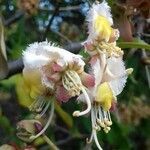Climber, up to 30 m, rarely shrub-like; internodes c. 5-7 cm; epiderm at first densely short fulvous-haired to glabrous, later crazed and scaling off, bark dull brown to shiny brownish black, often lenticellate. Leaves variable, pink or reddish and short-haired when young, getting green and subcoriaceous when older, c. 2-3 times as long as broad, (8-)10-15(-20) by (3-)4-6(-10) cm; base acute to rounded, mostly with 2 glands; margin often with glandular dots below; top acuminate, rarely acute or rounded; midrib slightly prominent above, more prominent beneath, nerves (4-)6-7 pairs, irregularly curved towards the top, smaller nerves sometimes sunken; upper surface often shiny and nearly always glabrous, lower surface glabrous, rarely very densely set with minute, appressed hairs or glabrescent; petioles 7-10 mm, dark-coloured. Inflorescences (4-) 10-20 (-35) cm long, fulvo-seri-ceous haired, rhachis stout, terete and 2-3 mm thick below, angular above. Bracts acute, 2-5 mm long. Pedicels terete, mostly thickened towards the flower, articulation about the middle, 2-bracteo-late, 1-2 cm, in fruit up to 3 cm. Gland convex, elliptic to lanceolate, 2-5(-6) mm long, about half on the calyx and half decurrent on the pedicel. Flowers 1-2.5 cm in diam., very fragrant, varying in colour between pink and sordidly white, the inner one or more petals partly yellow. Sepals ovate to elliptic, slightly subcoriaceous, top about truncate-rounded, 2-5(-8) by 1½-3(-4½) mm, outside always fulvous sericeous, inside often so, or glabrous. Petals orbicular to elliptic, (3-)6-12 by (2-)5-10 mm, more or less clawed, inside glabrous, outside haired, margin mostly fimbriate and glabrous, the inner petal with 2 outgrowths at the base. Short filaments 2-4(-10) mm, the long one 8-12(-18) mm long, mostly glabrous, anthers 1-2 mm. Style terete, with acute top. Samaras variable in size and shape, dark reddish when fresh, shiny brown when dry, glabrescent, middle wing elliptic or obovate, top obtuse, acute, or rounded, sometimes divided into 2 lobes, (3-)5-6(-7) by 1(-2) cm, lateral wings 2-3 by ½-l(-1½) cm; dorsal crest sometimes present.
More
Shrubs or lianas, 3-10 m or more; branchlets and inflorescences densely yellowish brown or silver-gray pubescent; branches glabrate, ferruginous-red or dark gray, with light-colored lenticels. Petiole 5-10 mm, canaliculate adaxially; leaf blade leathery, oblong, elliptic-oblong, or ovate-lanceolate, 9-18 × 3-7 cm, young leaves light red, pubescent, old leaves green, glabrous, base broadly cuneate or rounded, abaxially often with 2 glands, apex acuminate; lateral veins 6 or 7 pairs. Racemes axillary or terminal, 5-10 cm, inflorescence yellowish brown pubescent, glabrate; pedicels articulate at middle or distally; bracteoles subulate-lanceolate. Flowers very fragrant. Sepals broadly elliptic or ovate, 5-6 mm, apex rounded, densely yellow-brown pubescent; gland thick, large, oblong, ca. 1/2 adnate on pedicel. Petals white, base yellow maculate, or yellowish or pink, orbicular or broadly elliptic, 8-15 × 5-10 mm, pubescent, apex rounded, base clawed, margin fimbriate. Stamens differing in size, longest 8-12 mm, others 3-5 mm; anthers elliptic, 1-2 mm. Style ca. 12 mm, circinate. Samara body shortly sericeous, wings glabrous, abaxial wing elliptic or obovate-lanceolate, 3.5-5(-7) × 1-1.6 cm, apex entire or retuse, lateral wings lanceolate-oblong, 1.5-3 cm, base of wing with 1 triangular-crested appendage. Fl. Feb-Apr, fr. Apr-May.
Branches spreading. Leaf blades elliptic or ovate, larger blades 10–16 × 4–7(–9.5) cm, base cuneate, apex acuminate, abaxial surface glabrescent or sparsely sericeous, hairs short, straight, adaxial surface glabrous, bearing 2 larger glands at base and usually several small impressed glands in an inframarginal row. Flowers very fragrant; calyx gland 3–5 mm; petals long-fimbriate. Samaras: upper central wing 37–45(–52) mm, 2 lower lateral wings 17–27 mm.


